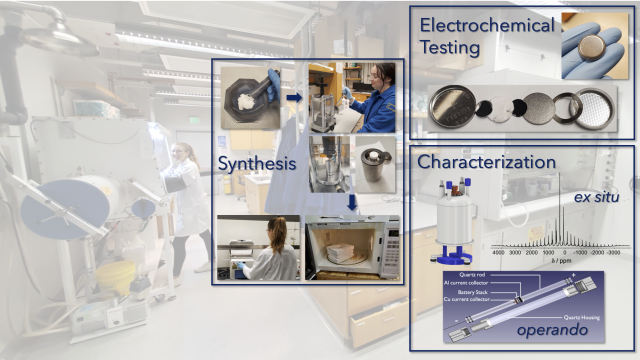Research
Rechargeable Batteries
The development of high performance rechargeable batteries has far-reaching consequences on many aspects of society, including the decarbonization of electric power sources, the establishment of local electric grids in regions not currently served by a reliable electricity supply, the widespread use of portable electronics and the electrification of transportation. Transition metal oxides are attractive electrode materials due to their high energy density. We currently investigate a range of transition metal oxide and oxyfluoride cathode materials for Li-ion and Na-ion battery applications. Our focus is on understanding structure-property relationships to devise novel materials with an optimal performance. For this, we use a variety of characterization techniques, including electrochemical testing, X-ray diffraction and Nuclear Magnetic Resonance (NMR) and Electron Paramagnetic Resonance (EPR) spectroscopy, as well as first principles calculations.
The commercialization of safer, flexible batteries calls for the replacement of flammable electrolytes based on organic solvents by non-flammable and mechanically robust solid electrolytes. We are currently studying a range of polymeric ionic liquid (PIL) electrolytes using NMR techniques to probe the mechanisms and speed of Li+ diffusion through the polymer network.

Development of Magnetic Resonance Techniques
NMR and EPR spectroscopies provide invaluable information on local structure and electronic structure changes taking place in electrochemical devices during normal operation. NMR probes the local structure around selected atomic species in a material and is becoming a technique of choice for the study of processes in electrode and electrolyte materials for battery and fuel cell devices. Since a large number of electrode materials are paramagnetic, i.e., contain unpaired electrons (usually coming from transition metal species), they can be investigated with EPR spectroscopy, which probes unpaired electron environments in the system. Our work endeavors to develop high resolution experimental NMR and EPR techniques for the study of paramagnetic electrode materials (e.g. containing unpaired transition metal electrons) and theoretical tools to predict paramagnetic NMR and EPR parameters. While most NMR and EPR studies of battery materials are currently done ex situ, i.e., by studying electrode or electrolyte samples stopped at different stages of charge or discharge, we are working towards the development of operando electrochemical cells that will allow us to follow redox and structural phenomena as the battery is being charged and discharged inside the NMR/EPR magnet.
Magnetic Resonance Facilities at UCSB
The spectroscopy facility of the Materials Research Laboratory at UCSB (see https://www.mrl.ucsb.edu/spectroscopy-facility/instruments) comprises an X-band cw-EPR spectrometer as well as several solid-state NMR spectrometers. The solid-state NMR instruments include a low field 100 MHz system equipped with a fast spinning 1.3 mm probe optimal for experiments on paramagnetic systems, a 300 MHz system equipped with a MRI/diffusion probe, a 400 MHz DNP-NMR spectrometer, and 500 MHz and 800 MHz systems equipped with fast spinning 1.3 mm probes, amongst others.
The Terahertz Facility of the Institute of Terahertz Science and Technology (ITST, see http://www.itst.ucsb.edu) hosts a free-electron laser (FEL), a powerful source of THz radiation, in combination with a 12.5 T superconducting magnet, enabling high frequency (240 GHz) high power cw-EPR.